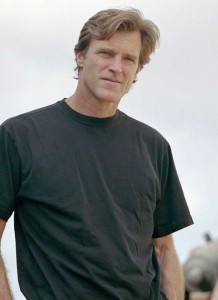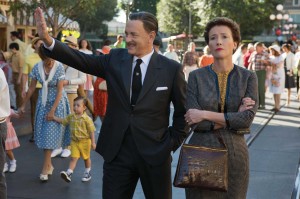![]()

Despite being a writer himself, Hancock doesn’t always write the films he directs. He explained, “The best thing that happened to me as a director was that I didn’t write my first movie, The Rookie. I was forced to embrace the job description of director, which I think first and foremost is to interpret the script. Whether I’ve written it or not, my job is the same. With The Blindside, you write it and then you’re the director and have to interpret it. That’s not to say that you don’t sort of have a leg up in terms of the history because you’ve done all the research, but you certainly have the same job.”
Except for composer, Thomas Newman, Hancock has collaborated with his key crew on past films. His cinematographer John Schwartzman started out on character-based dramas such as Benny and Joon, but moved into mega-million dollar action pictures when he was tapped by Michael Bay to shoot The Rock. Nevertheless, Schwartzman was interested in coming back to adult drama agreeing to shoot The Rookie for Hancock, and resuming his collaboration with the director on Saving Mr. Banks. “I love cinematographers,” Hancock admitted. “I’ve been blessed with very talented people.”
Hancock likes a lot of prep and loves to have his director of photography, production designer, costume designer and other keys together on a daily basis as early as possible because every decision made – and hundreds a day are made during prep – is a character decision. “If you approach everything through character and the storytelling then it gives you a leg up when you finally start shooting,” explained Hancock. “It’s all about character and what is the best way to tell this story.”
Although he is astute about the technology involved, in communicating his vision, Hancock tends to talk less from a technical standpoint, preferring to speak from a more emotional place. “I’ll talk to John about what I want to be feeling from this shot and here’s the reason I want it low and wide,” he explained. “We have a good rapport. We’re constantly bouncing ideas.”
Production designer Michael Corenblith was also involved in these conversations, so everyone was on the same page. “There is never a day when you walk on set and say, ‘Gee I wish we had a window here. There would be more natural light.’ It’s all been decided beforehand. We’re very much a measure twice and cut once type of bunch,” Hancock continued. “I laugh at Michael and say, ‘I’m going to be the lazy director here for a second.’ The more of the story that we can tell with every aspect and department, the easier it makes my job. The houses in Maryborough and Allora – let them tell the story that this is not a good move; this is not as nice as the place in Maryborough. Let the architecture be a character in the story.”
The production used many familiar locations such as the drive-up to the Beverly Hills Hotel, the exterior of the author’s Chelsea townhouse in London, and various locations on the Disney lot, such as the Buena Vista Street Gate, but it was necessary to build quite a lot of sets for the film. All the interior offices at Disney were constructed because the old animation building does not look the same on the inside as it did in 1961. “Disney’s office, the rehearsal room and her flat in London were built on stage,” revealed Hancock, who credited set decorator, Susan Benjamin, with her attention to detail in dressing the interior of the apartment. “Everything there meant something to P.L. Travers.”

When they first start discussing costumes, they don’t talk about tweeds and palettes, they talk about character. “If this is a dress that P.L. Travers is wearing, why did she buy it? Why is she wearing it today? What does she think it says about her? We all do that,” commented Hancock. “That’s interesting to me. That’s character motivated. With Michael and Daniel and John, it starts first with character, which is always the best discussion to have.”
Editor Mark Livolsi stays and works in New York where he lives, as opposed to being close to the set. Although the footage may be shot in a specific way that makes the director’s intentions for the scene obvious, Hancock does not like to dictate how the scene is constructed. “I believe his job is the next line of interpretation,” Hancock explained. “Initially I want him to look at all the footage and interpret it himself, because sometimes you’ll come in and look at it and go ‘Wow! I never thought that this would be edited this way, but it’s the best choice.’”
The order of scenes remained more or less the same as the screenplay and the edit stayed close to the script, with the exception of a few scenes in Australia that fell away in post. “We realized Kelly’s script was a little like a Swiss watch,” Hancock shared. “It looked effortless, but the mechanics of it were very precise. Things happened in an order for a reason.” The first cut was only two hours seventeen minutes in length because the team was very meticulous in the planning and prep.
Supervising sound editor Jon Johnson, who has worked on all the director’s films, is also an important contributor. Traveling between two time periods was a challenge from a tonal and thematic standpoint. “The music and the sonic quality drapes over from one shot to the next to help you transport in time,” said Hancock. The director realized that until re-recording mixer Dave Fluhr finished the audio, he was not going to know if a crucial scene in the movie worked – the intercut between Fidelity Fiduciary Bank being pitched to P.L. Travers in the rehearsal room and her father’s speech at the Allora Fair. “That is when we realized the 1961 events are impacting her memories to the point that Richard and Robert Sherman’s lyrics come out of the mouth of Travers Goff [Colin Farrell],” revealed Hancock. “It’s one thing to play with two different times, that’s difficult enough, but when one of them starts influencing the other…it’s a high wire act.”
The newest collaborator was Thomas Newman. The composer would mock-up and temp music into a scene, supplying different versions based on different character perspectives. “This is from Walt’s perspective. Now here’s music that plays from her perspective. Now here’s music that just plays the plot and serves as an engine for the scene,” explained Hancock. “So you are able to have real discussions about what the movie needed, what the characters wanted, and how to let the music be a character in the scene.” Although a director needs to tell a complete story with a beginning, middle, and end, for Hancock, every craft and performance in a film ultimately comes down to character.
Hancock has great respect for actors, especially ones of the caliber in Saving Mr. Banks. He shared a comment by Farrell. “Colin said something that I think is appropriate for this publication. He said, ‘I’ve always been offended by the signs that say Cast and Crew. We’re all crew. We’re all working on a movie together. I have a different job than you, but we’re all crew.’” Hancock concluded, “That’s the kind of attitude that I like to have on the set. We’re all making this movie.”





